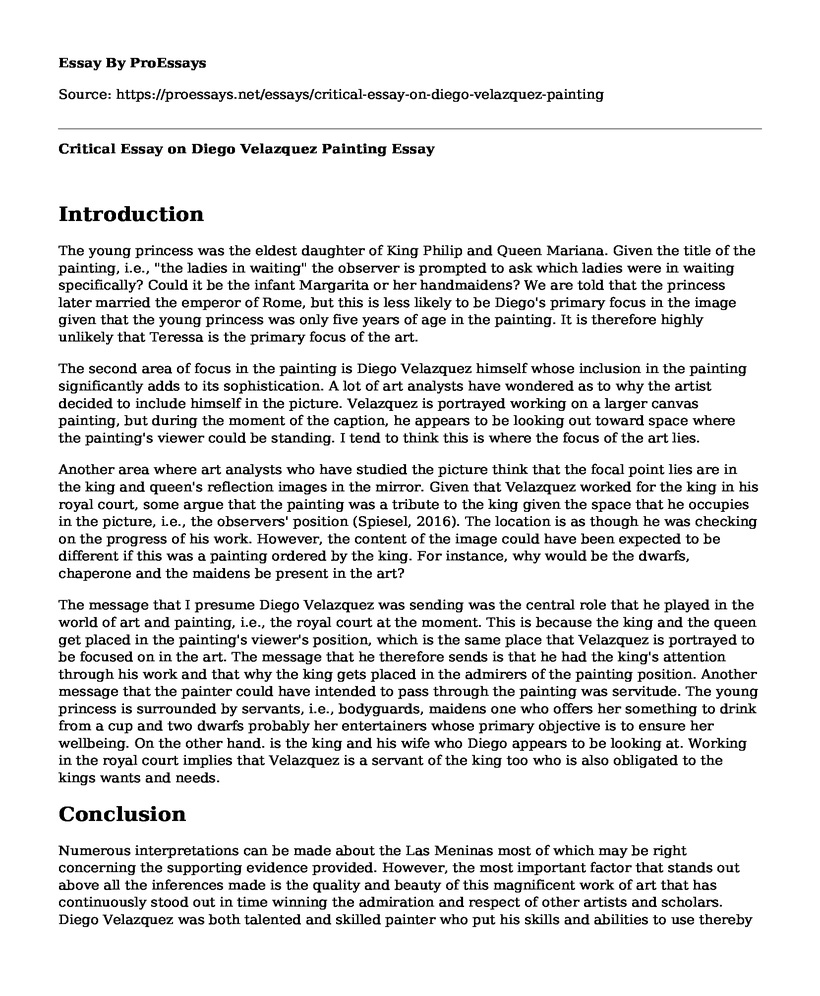Introduction
The young princess was the eldest daughter of King Philip and Queen Mariana. Given the title of the painting, i.e., "the ladies in waiting" the observer is prompted to ask which ladies were in waiting specifically? Could it be the infant Margarita or her handmaidens? We are told that the princess later married the emperor of Rome, but this is less likely to be Diego's primary focus in the image given that the young princess was only five years of age in the painting. It is therefore highly unlikely that Teressa is the primary focus of the art.
The second area of focus in the painting is Diego Velazquez himself whose inclusion in the painting significantly adds to its sophistication. A lot of art analysts have wondered as to why the artist decided to include himself in the picture. Velazquez is portrayed working on a larger canvas painting, but during the moment of the caption, he appears to be looking out toward space where the painting's viewer could be standing. I tend to think this is where the focus of the art lies.
Another area where art analysts who have studied the picture think that the focal point lies are in the king and queen's reflection images in the mirror. Given that Velazquez worked for the king in his royal court, some argue that the painting was a tribute to the king given the space that he occupies in the picture, i.e., the observers' position (Spiesel, 2016). The location is as though he was checking on the progress of his work. However, the content of the image could have been expected to be different if this was a painting ordered by the king. For instance, why would be the dwarfs, chaperone and the maidens be present in the art?
The message that I presume Diego Velazquez was sending was the central role that he played in the world of art and painting, i.e., the royal court at the moment. This is because the king and the queen get placed in the painting's viewer's position, which is the same place that Velazquez is portrayed to be focused on in the art. The message that he therefore sends is that he had the king's attention through his work and that why the king gets placed in the admirers of the painting position. Another message that the painter could have intended to pass through the painting was servitude. The young princess is surrounded by servants, i.e., bodyguards, maidens one who offers her something to drink from a cup and two dwarfs probably her entertainers whose primary objective is to ensure her wellbeing. On the other hand. is the king and his wife who Diego appears to be looking at. Working in the royal court implies that Velazquez is a servant of the king too who is also obligated to the kings wants and needs.
Conclusion
Numerous interpretations can be made about the Las Meninas most of which may be right concerning the supporting evidence provided. However, the most important factor that stands out above all the inferences made is the quality and beauty of this magnificent work of art that has continuously stood out in time winning the admiration and respect of other artists and scholars. Diego Velazquez was both talented and skilled painter who put his skills and abilities to use thereby significantly contributing to the world of art (Bueso et al. 2016). He will always remain a respected figure in his field and so will the Las Meninas.
References
Gaburri, E., & Ambrosiano, L. (2018). Las Meninas. In The Analytic Field (pp. 117-142). Routledge.
Soussloff, C. M. (2017). Foucault in painting. University of Minnesota Press.
Spiesel, C. (2016). A Las Meninas for the law. In Images in code (pp. 127-150). Routledge.
Bueso, E. S., Jean, R. S., Vinuesa-Silva, J. M., & Sanchez, J. G. (2016). Enfermedad ocular en la obra de Diego Velazquez (III). Las Meninas o La familia de Felipe IV. Museo Nacional del Prado (Madrid). Archivos de la Sociedad Espanola de Oftalmologia, 91(5), 1050-1052.
Knox, G. (2017). Las Meninas: social and structural perspectives. In The Late Paintings of Velazquez (pp. 135-160). Routledge.
Ramon-Laca, L. (2016). A Virtual Three-Dimensional Model of Las Meninas: Paradox or Mirror Image?. Leonardo, (Just Accepted).
Cite this page
Critical Essay on Diego Velazquez Painting. (2022, Aug 12). Retrieved from https://proessays.net/essays/critical-essay-on-diego-velazquez-painting
If you are the original author of this essay and no longer wish to have it published on the ProEssays website, please click below to request its removal:
- Paper Example on People's Identity Construction on Social Media Platforms
- Use of Symbolism in Nature in "Snow Falling on Cedars"
- Essay Example on Southern & Northern Renaissance Art: Secular & Religious Differences
- My Role Model Musician: Antonio Vivaldi - Essay Sample
- Paper Example on The Black Power Mixtape: A Movement's Journey 1967-1975
- Paper Example on Marginalized Non-Western Choreographers: Searching for Authenticity
- Analytical Essay Sample on the Importance of Reading for a Writer







